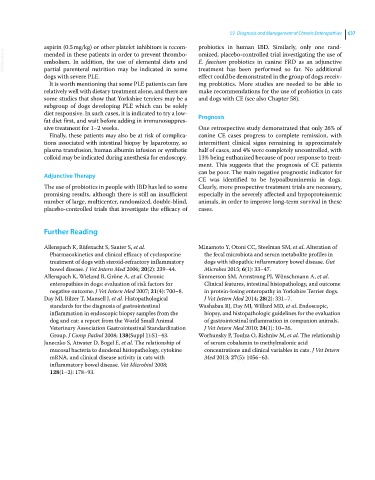Page 669 - Clinical Small Animal Internal Medicine
P. 669
59 Diagnosis and Management of Chronic Enteropathies 637
aspirin (0.5 mg/kg) or other platelet inhibitors is recom- probiotics in human IBD. Similarly, only one rand-
VetBooks.ir mended in these patients in order to prevent thrombo- omized, placebo‐controlled trial investigating the use of
E. faecium probiotics in canine FRD as an adjunctive
embolism. In addition, the use of elemental diets and
partial parenteral nutrition may be indicated in some
effect could be demonstrated in the group of dogs receiv-
dogs with severe PLE. treatment has been performed so far. No additional
It is worth mentioning that some PLE patients can fare ing probiotics. More studies are needed to be able to
relatively well with dietary treatment alone, and there are make recommendations for the use of probiotics in cats
some studies that show that Yorkshire terriers may be a and dogs with CE (see also Chapter 58).
subgroup of dogs developing PLE which can be solely
diet responsive. In such cases, it is indicated to try a low‐ Prognosis
fat diet first, and wait before adding in immunosuppres-
sive treatment for 1–2 weeks. One retrospective study demonstrated that only 26% of
Finally, these patients may also be at risk of complica- canine CE cases progress to complete remission, with
tions associated with intestinal biopsy by laparotomy, so intermittent clinical signs remaining in approximately
plasma transfusion, human albumin infusion or synthetic half of cases, and 4% were completely uncontrolled, with
colloid may be indicated during anesthesia for endoscopy. 13% being euthanized because of poor response to treat-
ment. This suggests that the prognosis of CE patients
can be poor. The main negative prognostic indicator for
Adjunctive Therapy
CE was identified to be hypoalbuminemia in dogs.
The use of probiotics in people with IBD has led to some Clearly, more prospective treatment trials are necessary,
promising results, although there is still an insufficient especially in the severely affected and hypoproteinemic
number of large, multicenter, randomized, double‐blind, animals, in order to improve long‐term survival in these
placebo‐controlled trials that investigate the efficacy of cases.
Further Reading
Allenspach K, Rüfenacht S, Sauter S, et al. Minamoto Y, Otoni CC, Steelman SM, et al. Alteration of
Pharmacokinetics and clinical efficacy of cyclosporine the fecal microbiota and serum metabolite profiles in
treatment of dogs with steroid‐refractory inflammatory dogs with idiopathic inflammatory bowel disease. Gut
bowel disease. J Vet Intern Med 2006; 20(2): 239–44. Microbes 2015; 6(1): 33–47.
Allenspach K, Wieland B, Gröne A, et al. Chronic Simmerson SM, Armstrong PJ, Wünschmann A, et al.
enteropathies in dogs: evaluation of risk factors for Clinical features, intestinal histopathology, and outcome
negative outcome. J Vet Intern Med 2007; 21(4): 700–8. in protein‐losing enteropathy in Yorkshire Terrier dogs.
Day MJ, Bilzer T, Mansell J, et al. Histopathological J Vet Intern Med 2014; 28(2): 331–7.
standards for the diagnosis of gastrointestinal Washabau RJ, Day MJ, Willard MD, et al. Endoscopic,
inflammation in endoscopic biopsy samples from the biopsy, and histopathologic guidelines for the evaluation
dog and cat: a report from the World Small Animal of gastrointestinal inflammation in companion animals.
Veterinary Association Gastrointestinal Standardization J Vet Intern Med 2010; 24(1): 10–26.
Group. J Comp Pathol 2008; 138(Suppl 1):S1–43. Worhunsky P, Toulza O, Rishniw M, et al. The relationship
Janeczko S, Atwater D, Bogel E, et al. The relationship of of serum cobalamin to methylmalonic acid
mucosal bacteria to duodenal histopathology, cytokine concentrations and clinical variables in cats. J Vet Intern
mRNA, and clinical disease activity in cats with Med 2013; 27(5): 1056–63.
inflammatory bowel disease. Vet Microbiol 2008;
128(1–2): 178–93.

